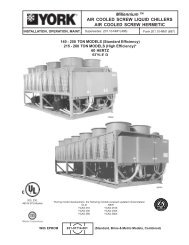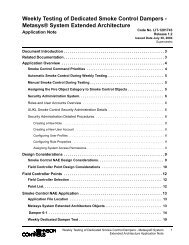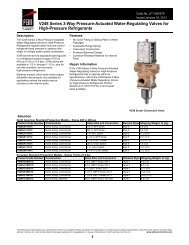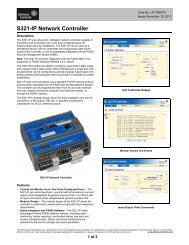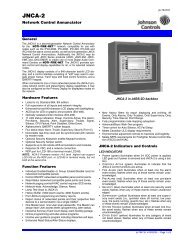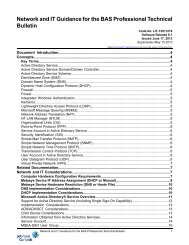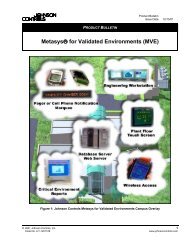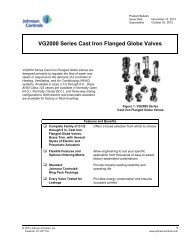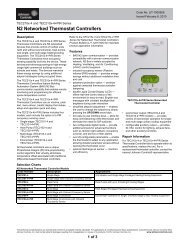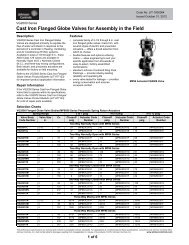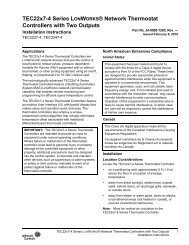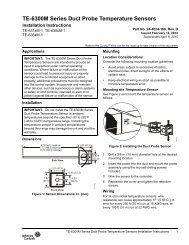TEC Zoning Control System for Stand-Alone and BACnet® MS/TP ...
TEC Zoning Control System for Stand-Alone and BACnet® MS/TP ...
TEC Zoning Control System for Stand-Alone and BACnet® MS/TP ...
- No tags were found...
You also want an ePaper? Increase the reach of your titles
YUMPU automatically turns print PDFs into web optimized ePapers that Google loves.
- It is possible <strong>for</strong> an internal zone to be slightly overcooled during peaksummer cooling loads. This situation happens when the rooftop controllersupplies its maximum cooling capacity, <strong>and</strong> when the volume of cold airdetermined by the minimum position of the zone damper during occupiedperiods is already providing too much cooling capacity to the internal zone.- It is also possible <strong>for</strong> an internal zone to be slightly overheated during peakwinter heating loads. This situation happens when the rooftop controllersupplies its maximum heating capacity; <strong>and</strong> when the volume of hot airdetermined by the minimum position of the zone damper during occupiedperiods is already providing too much heat, <strong>for</strong> which the internal zonesrarely need.• External zones considered to be of primary importance should have both theirheating <strong>and</strong> cooling weight set to 100%.• Zones considered to be of secondary importance may have their weight set to alesser value than 100%, to reflect the importance they have in the total votingdem<strong>and</strong> calculations.• Some zones (<strong>for</strong> example, an office surrounded by panoramic windows) mayexperience problematic behavior while in their peak heating or cooling mode,due to location, design, <strong>and</strong>/or degree of exposure. These problematic zonescan have their peak load dem<strong>and</strong> satisfied; however, this usually results inhigher energy costs since some of the other zones in the system are slightlyoverheated or overcooled. The installer is responsible <strong>for</strong> properly identifyingthese problematic areas <strong>and</strong> determining if they should be fully satisfied (at acertain energy expense) or if they should be left unsatisfied during specificpeak load periods, to reduce energy consumption <strong>and</strong> <strong>for</strong> the greater good ofthe rest of the zones in the system.- Adding many voting zones (including problematic areas) to a rooftopcontroller provides greater occupancy com<strong>for</strong>t at higher energy costs.- Restricting the number of voting zones (including problematic areas) to arooftop controller provides energy savings at the expense of occupancycom<strong>for</strong>t in some of the zones in the system.Minimum, Maximum, <strong>and</strong> Heat Flow AdjustmentsAlthough system balancing can be accomplished using configuration settingswithin the zone controller, we recommend installing a balancing damper at thebalancing side takeoff of all zones. A balancing damper reduces excessive airflow<strong>and</strong> the noise that goes with it, if the zones <strong>and</strong>/or associated ductwork areoversized.Minimum Position Adjustment (Min Pos Parameter)This parameter sets the minimum position of the zone damper to deliver theminimum amount of air to the zone in all conditions. When powered up, thedamper never closes below the minimum position setting.<strong>TEC</strong> <strong>Zoning</strong> <strong>Control</strong> <strong>System</strong> <strong>for</strong> <strong>St<strong>and</strong></strong>-<strong>Alone</strong> <strong>and</strong> <strong>BACnet®</strong> <strong>MS</strong>/<strong>TP</strong> Networked ApplicationsTechnical Bulletin27



